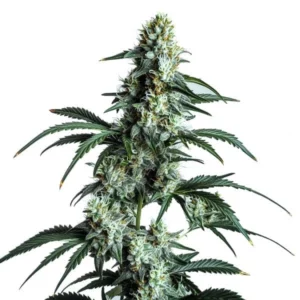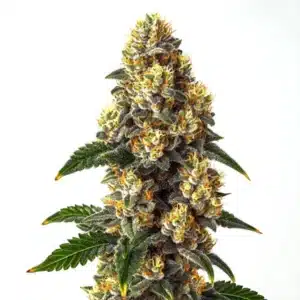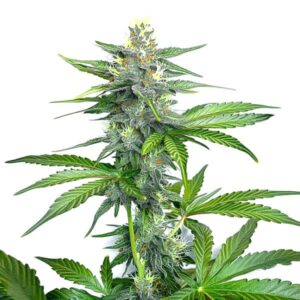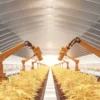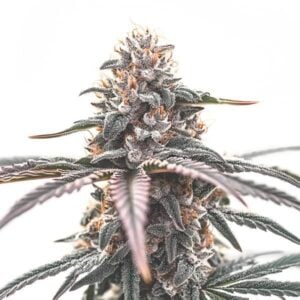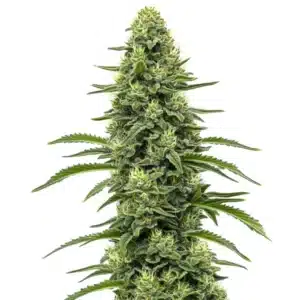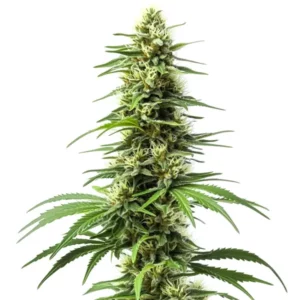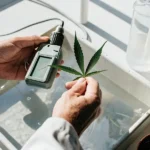
Phototropins and Cannabis Leaf Positioning
Phototropins are special proteins in plants that sense light. These proteins are vital for cannabis as they help the plant move its leaves toward the light. This movement ensures that the plant gets as much sunlight as possible to grow efficiently. In cannabis cultivation, knowing Phototropins and Cannabis Leaf Positioning is key, since it explains how leaves adjust to maximize light capture, ultimately leading to healthier plants and higher yields.
When cannabis leaves tilt towards the light, it’s not just a random act. Phototropins sense the direction of light and send signals to the plant. This signaling causes specific cells in the plant to grow more on one side, resulting in the leaf bending towards the light. This process is crucial for maximizing photosynthesis, the way plants convert light into energy.
Recommended Strains
Sour Diesel
|
|
THC | 22% - 25% (Medium) |
|
|
Type | Feminized |
|
|
Yield | High |
|
|
Phenotype | 30% Indica / 70% Sativa |
GG4
|
|
THC | 27% (High) |
|
|
Type | Feminized |
|
|
Yield | High |
|
|
Phenotype | 40% Indica / 60% Sativa |
The positioning of cannabis leaves in response to light is a fascinating subject for both novice and experienced growers. It’s about getting the most out of your plants by leveraging their natural abilities. Growing strains like Blue Dream, Sour Diesel, and Gorilla Glue 4 from Blimburn Seeds can benefit significantly from knowing these natural processes.
Phototropin Roles in Cannabis Leaf Movement
Phototropins have specific roles in how cannabis leaves move. They detect blue light and initiate a series of actions within the plant. These actions lead to leaf movement, ensuring that the plant captures more light. For growers, this means healthier plants and potentially bigger yields.
In practical terms, using phototropins to your advantage can mean positioning your grow lights more effectively. By ensuring your cannabis plants receive light from the right angles, you can stimulate optimal leaf positioning. This can be particularly useful when growing strains like Tangie, known for its vigorous growth and high yield potential.
Phototropins and Cannabis Leaf Positioning are integral to achieving optimal plant health and maximizing photosynthesis. This knowing allows for better control over the growing environment, enabling cannabis growers to fine-tune light conditions to suit specific strains. As growers become more adept at manipulating phototropin roles in cannabis leaf movement, they can expect improved growth outcomes.
Additionally, phototropins can help growers identify and correct imbalances in light exposure. By observing changes in leaf positioning, growers can adjust their lighting setups to ensure all parts of the plant receive adequate light. This attention to detail can be the difference between a good harvest and a great one.
Cannabis Leaf Positioning in Response to Light
Leaves are the solar panels of your cannabis plant. They need to be in the right position to capture sunlight effectively. Phototropins help with this by directing leaves to the best position to catch the light. This is crucial in indoor growing setups where artificial light is used.
Light-induced cannabis leaf orientation allows for a more efficient photosynthesis process. When leaves are correctly aligned, they can absorb more light, leading to better growth. This is especially important for strains like OG Kush, which thrive under optimal light conditions.
Knowing cannabis leaf positioning in response to light can enhance a grower’s ability to maximize yield. By utilizing the natural mechanisms of phototropins, growers can create an environment where plants can thrive. This involves strategic light placement and regular adjustments to accommodate plant growth stages.
Incorporating knowledge of phototropins and their effects on cannabis leaf positioning can lead to more sustainable growing practices. As leaves reposition themselves in response to changing light conditions, growers can reduce energy costs by optimizing light usage, ultimately leading to a more eco-friendly operation.
Promos & Deals
Phototropins Influence on Cannabis Growth Patterns
Phototropins don’t just affect leaf movement; they influence overall growth patterns. By understanding these proteins, growers can predict and enhance plant growth. This knowledge is essential for optimizing growth in various environments.
For example, phototropins can signal the plant to grow taller or bushier based on light conditions. This can be particularly useful for strains like Wedding Cake, which benefit from controlled growth patterns to maximize yield. The right light exposure can lead to a more robust plant structure.
Phototropins and Cannabis Leaf Positioning play a pivotal role in shaping the overall growth patterns of cannabis plants. By monitoring and adjusting light exposure, growers can manipulate plant morphology to suit their cultivation goals. This can lead to more efficient space usage and increased production in limited growing areas.
Knowing phototropins influence on cannabis growth patterns can also aid in the development of new cultivation techniques. By experimenting with different light spectrums and intensities, growers can discover new ways to enhance plant health and productivity, potentially leading to innovative breakthroughs in cannabis agriculture.

Light-Induced Cannabis Leaf Orientation
Light-induced orientation isn’t just about capturing light; it’s about ensuring your plant’s health. When leaves are positioned correctly, your plant can breathe better and avoid diseases. Good air circulation around the leaves helps in reducing mold and pest issues.
Moreover, properly oriented leaves can lead to more efficient nutrient uptake. This means your plant can grow faster and stronger. For those growing strains like Jack Herer, known for its resilience, effective leaf positioning can enhance its robust nature.
Implementing light-induced cannabis leaf orientation techniques can lead to a more resilient crop. By ensuring optimal light exposure, growers can minimize the risk of plant stress and enhance overall vitality. This proactive approach can result in more consistent yields and higher-quality harvests.
Phototropins and Cannabis Leaf Positioning, when leveraged correctly, can also contribute to the long-term sustainability of a growing operation. By reducing the incidence of disease and nutrient deficiencies through proper leaf orientation, growers can maintain healthier plants with less reliance on chemical interventions.
- Position grow lights to mimic natural light conditions.
- Rotate plants regularly to ensure even light exposure.
- Monitor leaf orientation to detect any growth issues early.
- Utilize strains like Blue Dream and Gorilla Glue 4 for optimal growth with phototropin benefits.
- Consider environmental factors like temperature and humidity that can affect light response.
FAQs
What are phototropins, and how do they affect cannabis plants?
Phototropins are proteins that help plants sense light. In cannabis, they play a significant role in how leaves position themselves to catch light. This movement ensures that the plant can photosynthesize effectively, leading to better growth and yields.
Knowing phototropins can help growers optimize their lighting setups. By ensuring that plants receive the right light exposure, growers can enhance growth patterns and potentially increase their harvest. This is particularly beneficial when growing high-yield strains like Sour Diesel or Tangie.
Phototropins and Cannabis Leaf Positioning are crucial for growers aiming to achieve the best possible results. By delving into the science behind these proteins, cultivators can better harness their power to improve plant health and productivity. This understanding can lead to more strategic and efficient growing practices.
With knowledge of phototropins, growers can make informed decisions about their cultivation strategies, leading to more predictable outcomes. This can be especially valuable in commercial operations where consistency and reliability are key to success.
How can light positioning influence cannabis growth patterns?
Light positioning plays a crucial role in how cannabis plants grow. Phototropins influence how leaves orient themselves, which affects the plant’s ability to photosynthesize. Proper light positioning can lead to healthier plants and improved growth patterns.
For instance, strains like Gorilla Glue 4 and Blue Dream can benefit from strategic light placement. By mimicking natural sunlight conditions, growers can encourage these plants to develop vigorously and produce abundant yields.
Effective light positioning can significantly enhance the effects of phototropins on cannabis growth patterns. By aligning light sources with the plant’s natural responses, growers can optimize photosynthesis and overall plant health, leading to more robust growth and larger yields.
Phototropins and Cannabis Leaf Positioning offer a roadmap for achieving optimal plant development. By knowing how to manipulate light conditions, growers can tailor their cultivation methods to meet specific strain requirements, ultimately leading to more successful harvests.
Why is cannabis leaf positioning important for growers?
Leaf positioning is vital because it directly affects how much light a plant can absorb. Phototropins help leaves move to the best position for light capture, which is essential for photosynthesis. This process is crucial for plant health and yield.
Growers can enhance their plants’ performance by understanding and utilizing phototropin signaling pathways. This knowledge helps in setting up effective lighting systems, ensuring plants like OG Kush or Wedding Cake receive optimal light exposure for maximum growth.
Cannabis leaf positioning in response to light is not only about maximizing photosynthesis but also about ensuring plant resilience. Proper leaf orientation can prevent issues related to light stress and heat damage, contributing to a more stable and productive growing environment.
By focusing on phototropins and Cannabis Leaf Positioning, growers can develop a deeper knowing of how to maximize their plants’ natural capabilities. This can lead to improved plant health, increased yields, and a more successful cultivation overall.
Can manipulating light affect cannabis plant height and structure?
Yes, manipulating light can significantly affect a cannabis plant’s height and structure. Phototropins respond to light conditions, influencing how the plant grows. By adjusting light exposure, growers can encourage taller or bushier growth, depending on their needs.
For example, strains such as Jack Herer may require specific light conditions to reach their full potential. By knowing phototropin roles in cannabis growth, growers can tailor their lighting setups to achieve desired plant structures and yields.
Phototropins and Cannabis Leaf Positioning allow growers to customize plant development according to their specific goals. By manipulating light exposure and positioning, growers can create plants that fit their desired profiles, whether it’s for height, bushiness, or overall vigor.
This level of control over cannabis plant phototropin signaling pathways can lead to more efficient use of space and resources. As growers become more adept at using light to influence plant structure, they can optimize their setups for better productivity and quality.
How do phototropins contribute to a cannabis plant’s overall health?
Phototropins contribute to a cannabis plant’s overall health by ensuring optimal leaf positioning for light capture. This positioning is crucial for efficient photosynthesis, which is the foundation of plant growth and health. Healthy photosynthesis leads to robust growth and higher resistance to diseases.
By optimizing light exposure through phototropin guidance, growers can promote better air circulation and nutrient uptake. This results in healthier plants that are better equipped to handle stressors. Strains like Tangie and Blue Dream can thrive under such optimized conditions, leading to successful harvests.
Phototropins and Cannabis Leaf Positioning are essential components in maintaining the overall health of cannabis plants. By ensuring that leaves are positioned to maximize light absorption, growers can support the plant’s natural processes, leading to stronger, more resilient crops.
Incorporating a deep understanding of phototropins influence on cannabis growth patterns into cultivation practices can result in healthier plants with reduced susceptibility to diseases and pests. This holistic approach to plant care can lead to more sustainable and successful growing operations.


